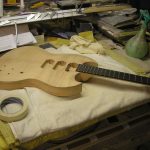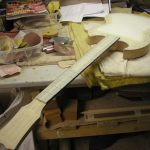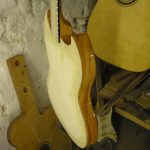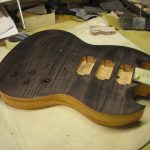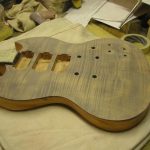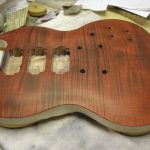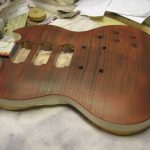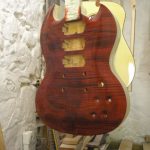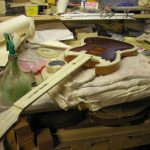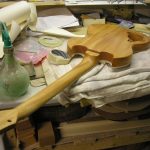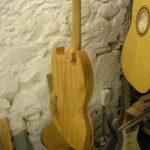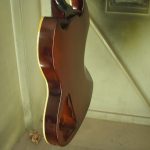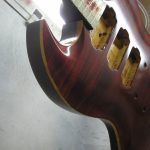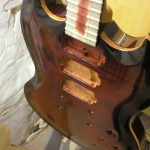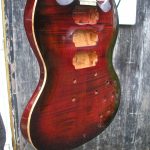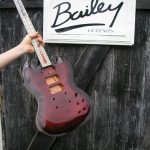…Stephen built this guitar on our BYOG course…. he wanted a stain and full gloss so he left it with us to spray.
- Sanded with 320 grit
- Masking front neck and headstock
- Waiting for sealer to dry
- Stain applied with soft cloth
- Stain sanded with 400 grit
- Stain wiped on not sanded
- Dark cherry red stain is applied not sanded
- The colour is sealed in
- Colour is masked to prevent overspray
- Masking done ready to spray colour
- Before the dark red
- After the dark red is sprayed
- Sanded with 800 grit
- Burst sprayed and sealed in
- Sanded with 800 grit then glossed
- Time for lacquer to fully cure before polishing
When a body is made by joining a cap onto a base wood and the cap is painted, the edge of the cap can be used to give the appearance of the guitar being bound, usually called fake or faux binding:
Steve wanted a dark red colour “think red wine” with the flame pattern in the wood to stand out, finished with a dark burst, and the back sides and neck were to be painted dark red.
After a final sanding with 320 grit it’s ready to prepare for painting. I masked the front of headstock, fingerboard and top face of the guitar. The top face will have the stain wiped on with a cloth directly onto the wood, and the rest will be sprayed with sealer, before spraying the colour.
The back sides and neck are then sprayed with sealer.
When dry the masking is removed from the front then a black stain is applied to the bare wood. When dry it is lightly sanded off. The black stain sticks in the ‘figure’ of the wood and comes off in between. It’s then given a coat of cherry red. This is called double staining.
It’s then sprayed with a coat of sealer.
Once dry, the top and bindings are masked. The edge of the binding on the sides is masked using fine line tape which leaves a perfect line when removed. The rest of the guitar (back and sides) is then sprayed with dark cherry red. The masking is removed and it is left to dry.
Next the sides, back, and neck, are masked in order to spray the burst. The sides are masked up to the still sharp edge between the sides and top, and the burst is then sprayed. When dry the masking is removed, and the sharp edge is then rounded off with 320 grit to finish the ‘fake’ wooden binding effect.
The whole guitar is then given two coats of sealer.
When dry the guitar is flattened with 800 grit, being careful not to rub through to the colour. It’s now ready for the gloss coats.
It’s given six coats of gloss, light sanding between coats. Now it will hang for a few weeks to fully harden before polishing.

